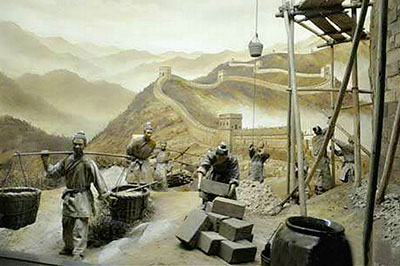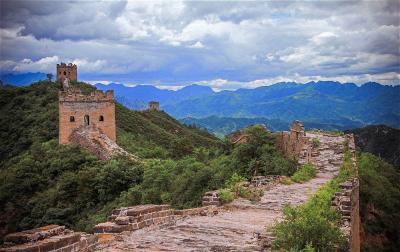Which Dynasty Built the Great Wall?
The construction of the Great Wall lasted for nearly 2000 years through more than 10 dynasties, including the Spring and Autumn Period, the Warring States Qin, Han Dynasty, Northern Wei Dynasty, Eastern Wei Dynasty, Northern Qi Dynasty, Northern Zhou Dynasty, Sui Dynasty, Liao Dynasty, Jin Dynasty, and Ming Dynasties.

At that time, King Xuan of Zhou built the Wall and its beacon towers to defend against the invading northerners. During the Spring and Autumn Period and the Warring States Period (late period of Zhou, 770-221 BC), the Great Wall entered its first climax as the Great Powers fought for supremacy and defended each other. But the length of the Wall was relatively short at this time.
The Chu Kingdom in southern China is believed to be the first vassal state to build the Great Wall. Before 656 B.C., the state of Chu built a wall, called the Fangcheng (Square Wall), on the border between Qi and Chu (around the present-day areas of Henan and Shandong) in order to defend itself against the attacks of the state of Qi. Historians generally consider this to be the beginning of the construction of the Great Wall of China.
Over the next 400 years, various vassal states, such as Qi, Wei, Zheng, Han, Qin, Yan and Zhao, built the Great Wall on their borders in order to protect themselves against the intrusion of others.
>> Related reading: Who Built the Great Wall of China?
Which Dynasties are Most Famous for Constructing the Great Wall of China
Large-scale construction of the Great Wall was carried out during the Qin, Han, Sui and Ming dynasties.
The first emperor to undertake the construction of the Great Wall was Emperor Qin Shi Huang of the Qin Dynasty. He ascended to the throne in 221 BC, at a time when China was divided into seven warring states. After the Qin Dynasty destroyed the warring states and unified the country, Qin Shi Huang connected and repaired the Great Wall of the Warring States in 220 BC. The resulting structure was an impressive feat of engineering, with walls that stretched for miles across some of the most difficult terrain in China.

The Great Wall of Han, also known as the Outer Great Wall, was built during the early years of Emperor Wu of Han Dynasty. After archaeologists' investigation, it was found that the Han Dynasty had built an “Outer Great Wall” of more than 10,000 kilometers from Dunhuang in Gansu Province in the west to Pyongyang in North Korea in the east. It is a wall that is fortified with ditches or natural terrain and consists of beacon towers ancient forts and barriers.
Due to its age, most of the Great Wall of the earlier dynasties is incomplete. And the better preserved ones we can still see today are those built in the Ming Dynasty. So people generally refer to the Great Wall of Ming Dynasty, and the length of the Great Wall is also the length of the Ming Great Wall. The most famous Ming Dynasty Great Wall include Mutianyu Great Wall, Badaling Great Wall, Jinshanling Great Wall, Juyongguan Great Wall, etc.The Great Wall was not without its flaws, however. Over the 2000 years, it was repeatedly breached by invading armies, and its effectiveness as a defensive structure gradually began to wane. Despite this, the Great Wall remained an important symbol of Chinese history and culture.
Recommended private Great Wall of China tours:
Why the Great Wall Was Not Built in Tang and Qing Dynasty?
Despite the importance of the Great Wall in Chinese history, it was not continued during the Tang Dyansty and Qing Dynasty.Emperor Taizong of Tang set the rule of not building the Great Wall. During the reign of Zhenguan, the Tang Dynasty was strong and superb in battle, with a large cavalry force. The Tang Dynasty was basically equal to the nomadic cavalry with its own cavalry, and was not at all outmatched. More importantly, the Tang dynasty had a number of generals who were very good at cavalry tactics.
Li Shimin, Emperor Taizong of Tang, once proudly said to his ministers, "Emperor Yang of Sui did not know how to choose generals and pacify the people on the frontier, so he could only rely on a dead object like the Great Wall for passive defence, while I appointed Li Ji to guard the frontier, the Turkic people will be afraid and panic when they see it and will not dare to come.”
The Qing Dynasty (1644-1912) was China's last imperial dynasty, and it was a time of great prosperity and cultural achievement. The border and ethnic relations of the Qing Dynasty were as strong as ever and there was no need to build the Great Wall.
Firstly, the north-east was the birthplace of the Manchus and was heavily garrisoned by the Eight Banners Army. Secondly, the United Mongolian policy effectively united the Mongolians, with Mongolian soldiers manning the frontiers. Third, the northwest had successively put down the Great and Small Hezhuo rebellions, set up the General of Ili to unify military and civil affairs, relocated soldiers and civilians from the interior to settle in the fields, and exercised direct rule over the northwest. Finally, the unification of Tibet in the west also gained the trust and obedience of the region.